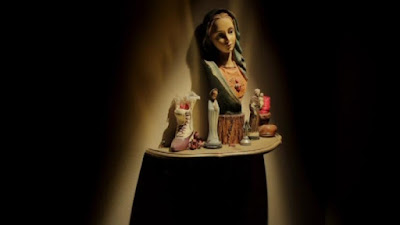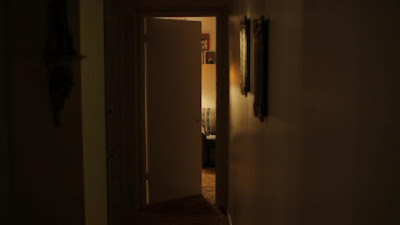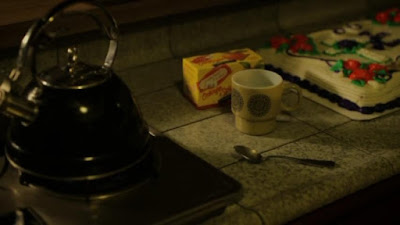
Today I have the great pleasure of presenting my first follow-up Q&A here at Moon in the Gutter with my friend, filmmaker Nicholas McCarthy. Nicholas previously shared his thoughts with us here on his terrific short-film Chinese Box and today he shares some details on his haunting new short, The Pact, and talks on his recent time at Sundance. Thanks to Nicholas for stopping back by here again and I hope everyone will try and seek out The Pact, as it is a very striking work.
Congratulations on your superb new short film The Pact, which is an extremely haunting and wonderfully provocative work. I know we covered a lot of ground in our first interview so I will just start the ball rolling on this one by asking you to tell us how The Pact came about?


The most important motivator was that I hadn't made a film in a while and I wanted to go though that process again -- working with actors and a crew, the editing, etc. Around the time I was getting the itch, I found myself re-watching a pair of favorite movies, RED DESERT and NOTORIOUS. I started to draw a connection between those two very different films about besieged women to a story I had been working on, off and on, for years, which I called THE PACT. The movie came together very quickly after that -- from the time I decided I was going to go for it to our shoot was less than six weeks.


Were there any particular films of filmmakers that proved inspirational for The Pact?
Besides the films I mentioned, the spirit of the story was inspired by Val Lewton's classic 40s horror films. They're such peculiar movies for the genre -- they take place in these very three dimensional worlds, they're literate, filled with ambiguity, and have an emphasis on actors. Visually we modeled shots on Dario Argento's films, which are as different from Lewton's as you can get. Specific shots were modeled on moments in SUSPIRIA. We also looked at Antonioni's BLOW-UP (where Argento pulled everything from anyway). My DP Bridger Neilson had never seen any of these movies, so I sat and watched them with him in pieces and we talked about what made them work.
Like your previous short, the excellent Chinese Box, The Pact is a two-character piece. Tell us a bit about the actors in The Pact and how it perhaps compares to Chinese Box.
I wrote the part of the brother in THE PACT specifically for Sam Ball, who did such an amazing job in CHINESE BOX. Sam's able to project this scattershot emotional presence which I love. For the part of the sister I wanted to work with someone new. A friend of mine sent Jewel Staite the script and she agreed to do it, which I was flattered by. Jewel is a star to many people who loved her on FIREFLY and STARGATE: ATLANTIS and she definitely didn't need to be in some tiny short film. But she responded to the material and did more than I ever could've hoped for with the part. I'll never forget looking in the monitor at the beginning of the shoot and watching her step in front of the camera for the first time. I knew right away she was embodying this role in a way I could never have planned. It's strange, but I've learned that's what you look for in every aspect of a film -- things you can't plan for. You just sort of lay the groundwork to try to coax good things into happening.
I continue to be impressed by your ability to create a fully realized work with such a short running time. I feel like in The Pact especially that you really gave your two characters a real sense of history. How difficult is it to create something that contains so much substance and keep it around the ten minute mark?
For me it's just about understanding the material in the most detailed way possible. And if you, your actors and your crew all have the same idea of who these people are and what the situation is, you can have confidence that everything will exist in there, somehow, for the audience.


I was impressed with the technical aspect of The Pact as well, particularly the haunting final shot that really plays extremely well with light and darkness. Tell us a bit about the crew you assembled and how long it took to shoot and then edit the film.
It took two days to shoot. It was a difficult time, because I had over 50 storyboarded shots. But we were able to get almost everything we needed. My friend Sam Zuckerman produced it, and I worked for a second time (after CHINESE BOX) with my DP Bridger and my editor Adriaan van Zyl, both of whom are phenomenal. For the first time I worked with production designer Walter Barnett, who brought nearly 20 years of experience to the shoot. Another first for me was collaborating with composer Ronen Landa, who wrote the incredible score.
Bridger does an amazing job photographing films and he paid close attention to the lenses we used, which are crucial to the look. The house we shot in also went a long way to creating the atmosphere in the film -- the house is really a character, and we really struck gold when we found that place, through a friend of a friend.
It was edited over three weeks, off and on. The score, sound mix and color correction came later, staggered out as these things are when people are doing something for nothing, on nights and weekends. The favors I got on this thing were amazing. A guy named Skip Kimball was our colorist. Skip did AVATAR! And here he was, doing our little movie.
So I know you got to take The Pact to Sundance. Can you perhaps give some advice to other filmmakers looking to get their film into such a well-known festival and tell us about your experiences there?

I played my first short in Sundance in 2005. I had hardly shown any of my previous work to anyone outside of a small group in LA., but this one Sundance programmer had seen some of my stuff and sort of had his eye on me and pushed me to submit to festivals and get into that world. I was really lucky in that regard.
What I realized when I went up to Sundance the first time is that there's a very strong group of filmmakers in the festival world who believe strongly in making movies and have that circuit as a community. Their lives are devoted to the cinema. Everything else, the crazy hype, is a sideshow.
Any particular highlights from the festival you would like to share with us and were there any films that really caught your eye we should look out for? Also, tell us a bit about the film The Pact opened for, The Oregonian.
I loved a lot of movies that I saw. THE OREGONIAN, which I played with, was directed by my friend Calvin Reeder, and it's insane. It absolutely divides audiences, sending some to the exits while others loved it unconditionally. It was crazy to witness.
The highlight of the festival for me was watching my own film in this one particular venue. It was a modern multiplex, and the screen was simply towering. I sat there looking up, never expecting to have seen this movie projected so large. My DP Bridger was there and once it was finished we just looked at each other, blown away. It was amazing.


How was the reaction to The Pact and were you pleased with how it was received?
When I submitted to Sundance this time I didn't know any of the shorts programmers and was absolutely sure they wouldn't care about the movie. A lot of that insecurity came from feeling like the movie was taking a big chance with its ending. After I was accepted and finally saw the movie with a large audience at the festival I realized not only did the movie make sense, but people were actually scared! A couple of people were so terrified they told me I "ruined" their night. One guy even asked me what happened at the end because he had hid his eyes for the last couple of minutes! It's strange and gratifying to hear things like this.


What can we expect next from you Nicholas?
Ummm… a feature. Stand by!
Tremendous, I hope you will come back by again and I can't think you enough for doing this follow-up for us. Congratulations on The Pact and the best of luck with your upcoming feature!
No comments:
Post a Comment